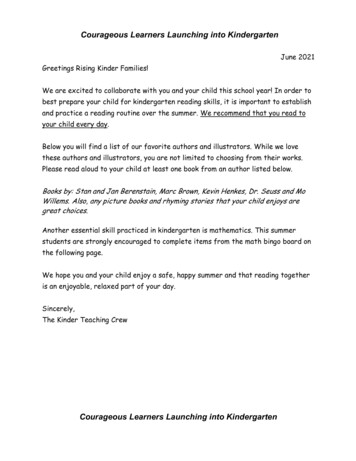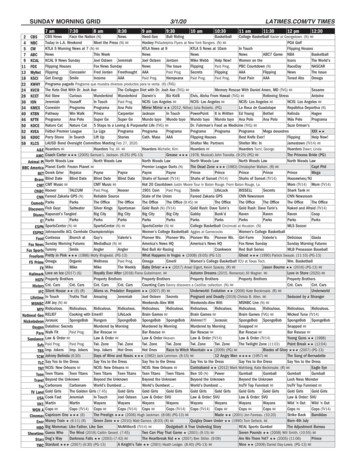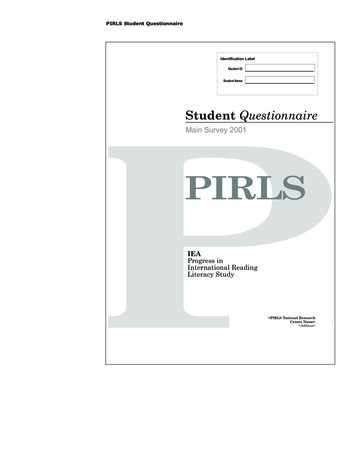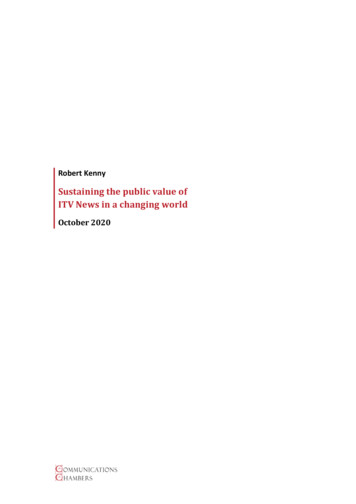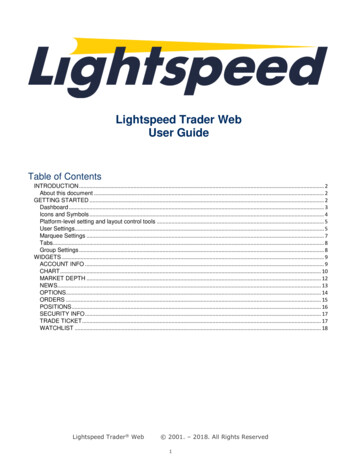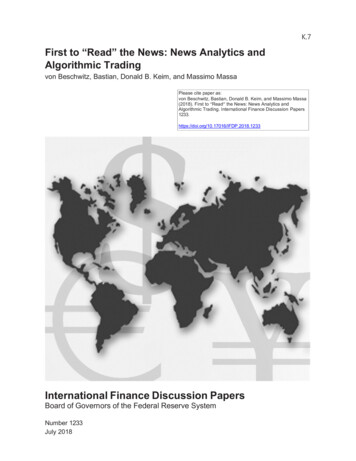
Transcription
K.7First to “Read” the News: News Analytics andAlgorithmic Tradingvon Beschwitz, Bastian, Donald B. Keim, and Massimo MassaPlease cite paper as:von Beschwitz, Bastian, Donald B. Keim, and Massimo Massa(2018). First to “Read” the News: News Analytics andAlgorithmic Trading. International Finance Discussion International Finance Discussion PapersBoard of Governors of the Federal Reserve SystemNumber 1233July 2018
Board of Governors of the Federal Reserve SystemInternational Finance Discussion PapersNumber 1233July 2018First to “Read” the News: New Analytics and Algorithmic TradingBastian von Beschwitz, Donald B. Keim, and Massimo MassaNOTE: International Finance Discussion Papers are preliminary materials circulated to stimulatediscussion and critical comment. References to International Finance Discussion Papers (otherthan an acknowledgment that the writer has had access to unpublished material) should becleared with the author or authors. Recent IFDPs are available on the Web atwww.federalreserve.gov/pubs/ifdp/. This paper can be downloaded without charge from theSocial Science Research Network electronic library at www.ssrn.com.
First to “Read” the News:News Analytics and Algorithmic TradingBastian von Beschwitz*Donald B. Keim**Massimo Massa***Federal Reserve BoardWharton SchoolINSEADMay 16, 2018AbstractExploiting a unique identification strategy based on inaccurate news analytics, we document acausal effect of news analytics on the market irrespective of the informational content of the news.We show that news analytics speed up the stock price and trading volume response to articles, butreduce liquidity. Inaccurate news analytics lead to small price distortions that are correctedquickly. The market impact of news analytics is greatest for press releases, which are timelier andeasier to interpret algorithmically. Furthermore, we provide evidence that high frequency tradersrely on the information from news analytics for directional trading on company-specific news.JEL classification: G10, G12, G14Keywords: Stock Price Reaction, News Analytics, High Frequency Trading, Press Releases.* Bastian von Beschwitz, Federal Reserve Board, International Finance Division, 20th Street and Constitution Avenue N.W.,Washington, D.C. 20551, tel. 1 202 475 6330, e-mail: bastian.vonbeschwitz@frb.gov (corresponding author).** Donald B. Keim, Wharton School, University of Pennsylvania, Philadelphia, PA 19104; keim@wharton.upenn.edu*** Massimo Massa, INSEAD, Finance Department, Bd de Constance, 77305 Fontainebleau Cedex, France, tel. 33-(0)160-724481, email: massimo.massa@insead.eduAn earlier version of this paper was titled "Media-Driven High Frequency Trading : Evidence from News Analytics". We aregrateful to RavenPack for providing their data, and Malcolm Bain in particular for his expertise on different RavenPack releases.Thanks also to the technical personnel at WRDS, especially Mark Keintz, for making the construction of the intraday-marketindexes possible. We thank Joseph Engelberg, Nicholas Hirschey, Todd Gormley, Markus Leippold, Joel Peress, Ryan Riordan,Paul Tetlock, Sarah Zhang and conference participants at the NBER Microstructure Meeting, European Winter Finance Summit,FIRS, and DGF for valuable comments. We acknowledge the financial support of the Wharton-INSEAD Center for GlobalResearch and Education. All remaining errors are our responsibility. The views in this paper are solely the responsibility of theauthors and should not be interpreted as reflecting the views of the Board of Governors of the Federal Reserve System or of anyother person associated with the Federal Reserve System.1
IntroductionA major purpose of financial markets is the assimilation of information into prices. Since theadvent of securities trading, informationally-relevant news has been read and processed byhumans, first directly from newspapers, then from news wires such as Dow Jones, Reuters, andBloomberg. However, in the last two decades, computer algorithms have increasingly been usedto read and interpret financial news. Given the importance of news for financial markets, it iscrucial to understand how the algorithmic processing of news releases by computers (“newsanalytics”) affects financial markets. In particular, in what ways do news analytics affect stockreturns and trading volume? Who are the users of news analytics? And for which type of articlesare news analytics most important?We address these questions using news analytics provided by RavenPack, the leading providerof news analytics in the market. RavenPack uses computer algorithms to determine for each articlein the Dow Jones Newswire its relevance to each company mentioned in it, and whether the newsis positive or negative. This processed content is then electronically delivered to RavenPack’ssubscribers within a third of a second, allowing them to react to the news faster than humanspossibly could.We address three broad questions in this paper. The first is whether news analytics have acausal effect on the stock market, making prices and trading volumes react faster to news wirearticles and thereby increasing market efficiency. The second asks for which articles is the causaleffect of news analytics most important. In particular, we compare press releases that are directlyreleased by companies to other articles that are written by the journalists of Dow Jones. The thirdasks whether news analytics are used only for directional trading or also to avoid adverse selection.2
We study this question by focussing on high frequency traders (HFTs), which we argue are thetype of trader most likely to use news analytics to avoid adverse selection.These questions are difficult to address in practice because the response to news analyticsnormally cannot be distinguished from the reaction to the news itself. We are able to address thisdistinction by exploiting a unique identification strategy based on inaccuracies in news analyticsthat are revealed by comparing older and newer versions of RavenPack. We use the back-filledanalytics of increasingly more sophisticated versions of RavenPack to identify inaccuracies in theold version that was released to the market. Finding evidence that markets react to suchinaccuracies would suggest a causal impact of RavenPack on the stock market.To identify inaccuracies in news analytics, we focus on differences in RavenPack’s “relevancescore”, which measures the importance of an article for a certain company. The relevance score isvery important: highly relevant articles that are positive (negative) are on average followed bypositive (negative) stock returns, while there is almost no reaction to articles with a low relevancescore. Differences in relevance scores between the old and new RavenPack versions are due toimprovements in the algorithm when identifying companies in the article and determining thearticle’s relevance to the company.We use these differences in relevance scores to define three categories of articles: Highrelevance articles Released as High-relevance articles (HRH) are articles that were correctlyreleased to the market; Low-relevance articles Released as High-relevance articles (LRH) are falsepositives, i.e. articles that are wrongly attributed to a company; and High-relevance articlesReleased as Low-relevance articles (HRL) are false negatives, i.e. articles that the old version ofRavenPack failed to attribute to the correct company.3
To assess the causal effect of Ravenpack, we start by focussing on LRH articles. We find thatthe market indeed reacts to such false positives, but the effect does not persist. The market initiallyoverreacts to the incorrect information, realizes the inaccuracy, and quickly corrects after 30seconds. This finding confirms the causal effect of RavenPack on stock prices but also suggeststhat the market is quite resilient against disturbances from inaccurate news analytics.To reinforce our finding of a causal effect, we examine the difference in the market’s reactionto HRH and HRL articles. These two article types are of similar relevance according to the mostrecent version of RavenPack, but only HRH articles were released to the market as highly relevant.Because HRL articles were incorrectly released as not relevant, they should not trigger a causaleffect on stock prices. Thus, comparing the difference in market responses between HRH and HRLarticles allows us to assess the causal effect of RavenPack.We find that the share of stock price reaction concentrated in the first 5 seconds after an article,compared to the total reaction over 120 seconds, is significantly greater for HRH articles than forHRL articles. This speed of the stock price response is 1.3 percentage points higher for HRHarticles, or 10% relative to the mean. The market not only reacts faster to HRH articles, but it alsoreacts in the sentiment direction indicated by RavenPack. The RavenPack sentiment direction ofan article predicts the stock price reaction to HRH articles better than to HRL articles. This impliesthat traders use RavenPack to trade in the direction of the sentiment indicator provided by the newsanalytics.In addition to the faster stock price response, we also document an increase in the share oftrade volume concentrated in the first 5 seconds compared to the two minutes after an article. Thisincrease in the speed of trade volume response is consistent with the theoretical prediction thatinvestors with a speed advantage trade aggressively on signals that they can exploit before other4
traders (e.g., Foucault, Hombert, and Rosu (2016)). Taken together, these findings confirm thatRavenPack has a causal effect on the stock market, resulting in both prices and trading volumereacting more quickly to the information delivered by news analytics and, thereby, improvingmarket efficiency.Having established the baseline finding that news analytics affect the stock market, we ask forwhich article types news analytics have the largest causal effect. We distinguish between pressreleases that are directly released by companies and articles written by Dow Jones’ journalists, andfind that RavenPack has a statistically significantly larger effect for press releases. The speed ofstock price response increases 2.6% for press releases that are HRH, while it increases only 0.8%for other HRH articles. This difference is even starker for trading volume: Being correctly coveredin RavenPack increases the speed of trade volume response by 1.4% for press releases but only byan insignificant 0.2% for other articles. Taken together, these results confirm that the effect ofRavenPack is mainly concentrated in press releases.Why do news analytics have a larger effect for press releases than for other articles? We showthat press releases are timelier: they are 8% more likely to be the first article of the day for thecompany and 17% more likely to be a new news story rather than a reprint of an earlier story. Inaddition, RavenPack sentiment is more accurate for press releases, correctly predicting thedirection of the stock price reaction in the 2 minutes around the article more often.These findings are consistent with the notion that traders view RavenPack as being morereliable for press releases. We extend this idea to the time series, by asking whether users ofRavenPack learn dynamically about its signal quality. We find that they do: the causal effect ofRavenPack on the 5-second return is stronger if RavenPack has been more informative in the past6 months, measured by whether sentiment scores accurately predicted 2-minute returns following5
the article. This finding suggests that algorithmic traders learn dynamically about the precision ofRavenPack, and that they rely more heavily on RavenPack’s sentiment scores if these scores havebeen more informative in the past. Such learning could be programmed into their algorithms(machine learning) or can come from manually updating their algorithms over time.Next, we focus on the two ways in which traders can use news analytics. They can either usethem to get an informational edge to conduct directional trades, or they can use them to learn whento get out of the market to avoid adverse selection or elevated order execution costs. The causaleffects of RavenPack on returns and trading volume clearly suggest that RavenPack is used fordirectional trading. But is it also used to avoid adverse selection?To examine this question, we focus on high frequency traders (HFTs). HFTs are a subset ofalgorithmic traders that have invested heavily to gain a speed advantage, for example through colocation at an exchange or hyper-fast connections between different exchanges (such as microwavetowers). Common trading strategies associated with HFTs include market making and cross-venuearbitrage (Boehmer, Li, and Saar (2017), Zhang (2017)). While executing these strategies, HFTssubmit limit orders that are at risk of being picked off when new fundamental information reachesthe market. Therefore, we believe that HFTs are the class of trader most likely to use RavenPackto avoid adverse selection. They would hold their usual algorithms and cancel their outstandingorders whenever a new article about the firm is released.To study this question, we use the NASDAQ high frequency trading data first used inBrogaard, Hendershott and Riordan (2014) which identifies the traders that NASDAQ knows areHFTs. Because this sample is limited to 120 stocks and just two years of data (2008-2009), acomparison between HRL and HRH articles is not feasible. Instead we conduct a simple timeseries comparison on how the release of RavenPack to the market affects HFT trading for all6
relevant articles. We focus on the fraction of HFT trading in the 5 seconds after an article,standardized by the fraction of HFT trading in the 120 seconds after the article. If HFTs useRavenPack to avoid adverse selection, we would expect this measure to decrease. Instead, itincreases by 1.8% after the release of RavenPack, indicating that HFTs make up a larger fractionof trading in the 5 seconds after an article once RavenPack is live. We also find, in line with ourprevious results, that this effect is much stronger for press releases. Moreover, we find that HFTsmainly increase their liquidity demanding trades after an article and that these trades arepredominantly in the direction of the article sentiment. Taken together, these results suggest thatHFTs do not use RavenPack to avoid adverse selection but rather to place directional bets.Given that even HFTs mainly engage in liquidity demanding trades after the release of anarticle, we ask whether RavenPack causes a faster decline in liquidity following articles. The ideais that the directional trades triggered by RavenPack hit existing quotes and cause liquidity todecline following an article. We find that this is indeed the case. Both effective spreads andAmihud illiquidity increase in the five seconds following an HRH article (compared to HRLarticles).A series of robustness checks confirm our results. One potential concern is that HRH articlesmay be systematically different from HRL articles. We address this concern in two ways. First, weshow that HRH and HRL articles are similar in terms of long-run stock price reactions and severalother characteristics. Second, we use the fact that RavenPack has back-filled the data of all versionsto February 2004 and conduct placebo tests during the time before RavenPack went live. If ourresults are driven by actual differences between the two article types, rather than a causal impactof RavenPack, then we should find significant differences in price reactions before RavenPackwent live. However, for all tests before RavenPack went live we find insignificant differences7
(between HRH and HRL articles). Moreover, the stock price reactions to HRH and HRL articlesstart to diverge precisely when RavenPack went live, and the resulting increase in the differencebetween HRH and HRL articles is significant. All of this suggests that our results are robust.In this paper we show that many algorithmic traders, including HFTs, use RavenPack fordirectional trading. This results in RavenPack having a significant impact on the market in termsof returns, trading volume, and liquidity. This effect goes beyond the underlying influence of thenews itself. While our study can only detect the effect of RavenPack, there are other providers ofnews analytics, and traders may conduct algorithmic news processing in house. Thus, the totaleffect of algorithmic news processing is likely much larger than the effect of RavenPack measuredin this paper. Also, given that RavenPack is the leading provider of news analytics, we expect theresults to carry through to wide-subscription news analytics services more generally.Our results contribute to four major strands of literature. First, we contribute to the literatureon the causal effect of media on the stock market.1 Methods to address the endogeneity of mediacoverage include exogenous scheduling of journalists (Dougal, Engelberg, Garcia, and Parsons,2011), local media coverage and its delay due to extreme weather (Engelberg and Parsons, 2011)and newspaper strikes (Peress, 2014). We add to this literature in three ways. First, we study newsanalytics, rather than news articles themselves. News analytics are special in that they are aderivative of news articles that contain less information than the article itself. Their only advantageis that they are easier to process algorithmically. Our results show that in the age of algorithmictrading, processability is just as important as informational content. Second, we study the effect of1There is a wider literature on media and stock markets including for example Chan (2003), Tetlock (2007, 2011),Fang and Peress (2009), Griffin, Hirschey, and Kelly (2011), Boudoukh et al. (2016), Loughran and McDonald (2013),Garcia (2013), Ferguson et al. (2015), Hu, Pan, and Wang (2017)). For a review on textual analysis in finance seeKearney and Liu (2014).8
such news analytics on algorithmic traders rather than private investors. This focus increases thepolicy relevance of our findings in a regulatory environment that is increasingly focused on newsanalytics. Third, we show that the impact of news analytics on prices are particularly important forpress releases, which are not the subject of the prior studies.Second, we contribute to the literature on news analytics. Prior papers in this literature studythe correlation between the market and news analytics without passing judgment on whether thereis a causal impact of news analytics on the market (e.g. Dzielinski and Hasseltoft (2017), Riordan,Storkenmaier, Wagener, and Zhang (2013), Gross-Klugmann and Hautsch (2011), Sinha (2016),Heston and Sinha (2016)). In contrast, our paper is the first to show the causal impact of newsanalytics on stock markets.Third, we contribute to the growing empirical literature on algorithmic and high frequencytrading.2 Several papers show that high frequency traders use information from order flow (e.g.Hirschey (2018) or information from related asset prices (e.g., Chaboud et al. (2014), Boehmer,Li, and Saar (2017), Zhang (2017)). In contrast to these studies, we show that HFTs do not onlytrade on market information, but also enter directional bets based on news analytics, which containnew, company-specific information that is not yet reflected in any market prices.Fourth, our results are consistent with recent models of high frequency trading in which sometraders have an informational advantage. For example, Foucault, Hombert, and Rosu (2016) modela situation in which a speculator receives information one period ahead of the market maker in a2Examples of this literature include Brogaard, Hendershott and Riordan (2014), Boehmer, Fong and Wu (2015),Hendershott and Riordan (2013), Hendershott, Jones, and Menkveld (2011), Baron, Brogaard, Hagströmer, andKirilenko (2017), Menkveld (2013), Jovanovic and Menkveld (2010), Riordan and Storkenmaier (2012), Boehmer,Fong, and Wu (2015), Hasbrouck and Saar (2013), Benos and Sagade (2016), Clark-Joseph (2013), Hirschey (2018),Brogaard et al. (2014), Chordia, Green, and Kottimukkalur (2017). A survey of this literature is provided by Jones(2013).9
set-up similar to Kyle (1985); in Martinez and Rosu (2013) some agents have a short-livedinformational advantage; and in Dugast and Foucault (2017), speculators face a trade-off betweenprocessing a signal faster or more accurately. Faster traders in these models make markets moreinformationally efficient, but also more unstable. We find support for both effects.2. Test design, identification strategy, and data sourcesIn this section we first describe the RavenPack news analytics data and how it is used in ouridentification strategy and tests. After briefly describing our stock market data, we then presentsummary statistics for the variables used in our tests. Variable definitions are in Appendix 1.2.1 RavenPackRavenPack provides real-time news analytics based on the Dow Jones (DJ) Newswire. This serviceanalyzes all the articles on the DJ Newswire with a computer algorithm and delivers article-levelrelevance and sentiment metrics to its users. It determines which companies are mentioned in thearticle, how relevant the article is to the company and reports different sentiment indicators aboutwhether the article is good or bad news for the company. The latency – i.e. the time from therelease of the DJ Newswire to the release of the RavenPack metrics – is approximately 300milliseconds. RavenPack claims it has the “timeliest company sentiment indicators in themarketplace.”3 As such, RavenPack is ideally suited for the use of traders engaging in algorithmicnews trading.2.1.1 Ravenpack – definition of variablesWe extract from RavenPack the following variables. Article Category is a variable determiningthe topic of the article and the role played by the company in the article. For example, Article“RavenPack Enables Trading Programs with Sentiment on 10,000 Global Equities,” RavenPack press release fromMay 28, 2009.310
Category might be “acquisition – completed – acquirer” for a company announcing the completionof an acquisition of another company or “rating – change – negative – rater” for a rating companythat just downgraded another company. The identification of the news topic is based on a purelyalgorithmic approach, and a large percentage of articles cannot be classified in this way. ArticleCategory Identified is a dummy variable equal to 1 if Article Category is identified by RavenPack,and zero otherwise.There are two major sentiment scores in RavenPack. The Composite Sentiment Score (CSS)is based on several individual RavenPack sentiment measures. It takes a value ranging from 100(positive) to 0 (negative), where 50 is a neutral article. It is available for each article. The EventSentiment Score (ESS) is coded in the same way as CSS, but available only if the category of thearticle can be identified. We aggregate these two scores into a single sentiment variable calledSentiment Direction, which is primarily based on ESS and uses CSS only if ESS is either missingor equal to 50 (neutral).Relevance is an index provided by RavenPack that indicates the relevance of an article to thecompany. Relevance takes values ranging from 0 (least relevant) to 100 (most relevant). If the typeof the article can be identified and the company plays an important role in the main context of thestory – e.g. is an acquirer or announces a buyback – then Relevance is 100. If the company ismentioned in the title, but the type of article cannot be identified, then Relevance ranges between90 and 100. If the company is mentioned, but plays an unimportant role, then it gets a lowRelevance score – e.g., a bank advising an acquisition might get a score of 20. We would not expectsuch articles to affect the bank’s stock price very much.In line with this, RavenPack recommends “filtering for Relevance greater than or equal to 90as this helps reduce noise in the signal”. To examine this claim, Figure 1 plots the market reaction11
to news as a function of Relevance. We plot the cumulative returns relative to news events fromApril 1, 2009 to September 10, 2012. We multiply returns by the article’s sentiment direction. Thearticles with Relevance greater than 90 do indeed have an important effect on stock prices, butthere is no reaction to articles with Relevance below 90. Thus, we will refer to articles withRelevance below 90 as low relevance. This analysis suggests that RavenPack is good at identifyingboth relevance and sentiment of an article.That the reaction to high relevance articles starts about 60 seconds before the article suggeststhat some of the news events are covered in other news sources before they are covered in the DJNewswire (used by RavenPack). Cases where the DJ Newswire is not the first to report an eventshould only work against us by making it more difficult to find a causal impact of RavenPack. Wehave no reason to believe that this issue should bias the results because it should be unrelated towhether RavenPack makes a mistake interpreting the article. While some trades in the 5 secondsafter a RavenPack article may be due to human traders reacting to earlier coverage of the newselsewhere, this trading should affect both HRL and HRH articles. Thus the additional tradingfollowing HRH articles (relative to HRL articles) should only be due to algorithmic tradersreacting to the coverage in RavenPack itself.2.1.2 Ravenpack – test design using different product versionsRavenPack released its first version (v. 1.0) to the market on April 1, 2009,4 5 and a revised versionof the service (v. 2.0) with additional features on June 6, 2011. The most recent version we use (v.4Even though the official release date of the RavenPack service was May 2009, some customers had access to theservice as early as from April 1, 2009. Thus, we refer to April 1, 2009 as the introduction of RavenPack. Before April2009 RavenPack had a pre-existing service that also released sentiment information on the Dow Jones News Wire.However, this service was meant for longer term news analysis, such as charting sentiment over several days. Theprior service was not provided timely enough to be used at high frequency.5RavenPack 1.0 was actually released on Sept 6, 2010. A predecessor to v.1.0, that was similar to v.1.0, is the versionthat was released on April 1, 2009. This predecessor version was not made available to us, but RavenPack confirmedthat it was very similar to RavenPack 1.0.12
3.0) was released on September 10, 2012. RavenPack has provided us with data from each of therelease-specific algorithms, each having been back-filled to February 2004. RavenPack does notcontinuously update its algorithm, so as not to distort its customers’ trading strategies which mightbe based on specific variable definitions. Rather, RavenPack rolls out any changes to its algorithmwhen releasing a new version, meaning that stock-specific metrics from the three releases cansometimes differ.6 These differences are often related to the way companies are identified in anarticle and how the relevance of an article to a company is determined. 7 Thus, there are articlesthat might be associated with a particular company in one RavenPack release, but not in another.Such differences in the relevance of articles to companies in different versions provide the basisfor our tests. Assuming the most recent version of RavenPack (v. 3.0, hereafter New RavenPack)is the most accurate, we can identify inaccuracies in RavenPack 1.0 and RavenPack 2.0 (hereafterOld RavenPack) that were released to the market. If the market reacts to these inaccuracies, it isan indication of a causal effect of RavenPack on the stock market.Our analysis can be thought of as assuming two types of traders: Algorithmic traders thatsubscribe to RavenPack and human traders that manually read the article to determine its content.Further, we assume that human traders can more precisely derive the relevant signal from thearticle, while algorithmic traders have an advantage in terms of speed (a setting modelled byDugast and Foucault (2017)). This means that RavenPack allows its subscribers to trade faster ona possibly less precise signal. In the short run, when only algorithmic traders can react to news,6Because the algorithm is proprietary, we do not know exactly what changes RavenPack implemented but someexamples of articles where the two versions disagree are provided in the Internet Appendix.7In addition, the number of companies covered by RavenPack has also increased between releases. There are 156companies (3%), which are only covered in New RavenPack. We ensure by using company fixed effects that thisdifference in coverage is not driving our results.13
RavenPack will have the largest impact; while in the long run human traders determine the pricereaction because their signal is more precise.In the empirical implementation we choose specific time intervals to constitute the short andlong run. We define the short run to be 5 seconds, because this is long enough to capture the fullreaction of algorithmic traders (and accommodates slower algorithmic traders that are not colocated and not trading within milliseconds), but is too short for a human trader to read an article,process it and make a trading decision based on it. We choose two minutes as the long run becausethis permits enough time to read an article and trade on it, whereas longer time windows will bemore affected by noise. In the Internet Appendix, we provide robustness checks in which we useboth 1 and 10 seconds for the short run and 5 minutes for the long run.We define the following article types that we also list in Panel A of Table 1. High relev
Algorithmic Trading von Beschwitz, Bastian, Donald B. Keim, and Massimo Massa International Finance Discussion Papers Board of Governors of the Federal Reserve System Number 1233 July 2018 Please cite paper as: von Beschwitz, Bastian, Donald B. Keim, and Massimo Massa (2018). First to “Read” the




